Charging Guide: Electric Vehicle Fast Charging
What is fast charging, semi-quick charging and normal charging?
The difference between these different terms is mainly the power (number of kW) that is being supplied to the car battery per unit of time and where the charger is located. The image illustrates the difference between AC and DC charging.
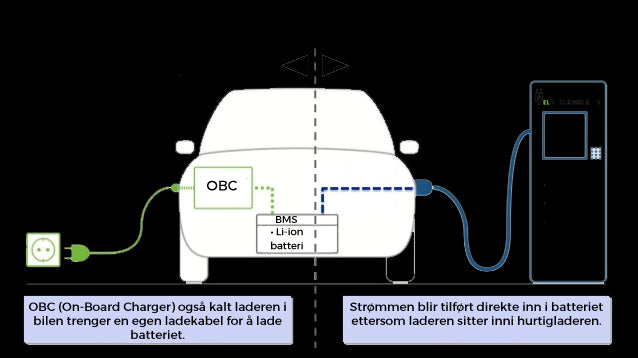
Fast Charging: With fast charging, you supply significantly more power to the battery compared to normal charging. An external charging station provides the car with direct current (DC) directly to the battery and is referred to as (mode 4), typically filling the battery from 0-80% in 30-60 minutes. Fast charging is classified as an effect of 43kW or more. In Europe, there are mainly three standards described below. You can find fast charging stations around grocery stores, gas stations, and other convenient locations, and you do not need your own cable for fast charging as the charging cable is already permanently attached. Use websites and applications to locate where the fast charging stations are.

Fast charging station with Type 2 (AC), CHAdeMO (DC), and CCS Combo 2
Semi-fast charging: Provides the car with alternating current (AC) to the charger in the car and charges the car in 3-4 hours (the time depends on battery size and the car's internal charger). Semi-fast charging is classified as a power from 22kW to 43kW, i.e., from 32A/3-phase/400V and more. Note that higher powers for AC charging are very rare in Norway. Semi-fast charging is normally achieved via mode 2 or mode 3 charging.

Mode 3 charging station with type 2 connector - AC charging with up to 22kW (400V/3-phase)
Standard charging: Powers less than 22kW are called standard charging. This is what the majority of electric vehicle owners use at home. The charging box (charging station or charging cable) provides the charger in the car with alternating current (AC) which is converted to direct current (DC) that fills up the battery. This can range from 6-32A both 1-phase and 3-phase and is defined as mode 2 or mode 3 charging.
Standards for fast charging
As of today, there are three standards for fast charging in Europe, namely CHAdeMO, Combined Charging System (CCS), and Tesla's modified type 2 (Supercharger / SuC).
CHADEMO

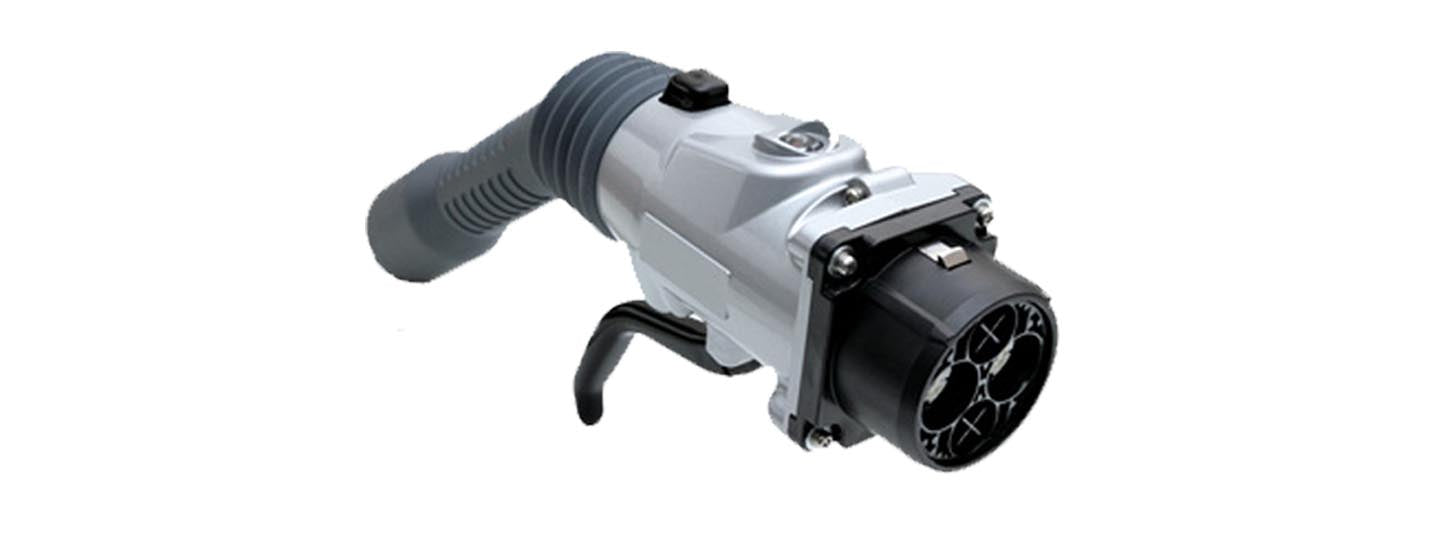
Charging plug for the car
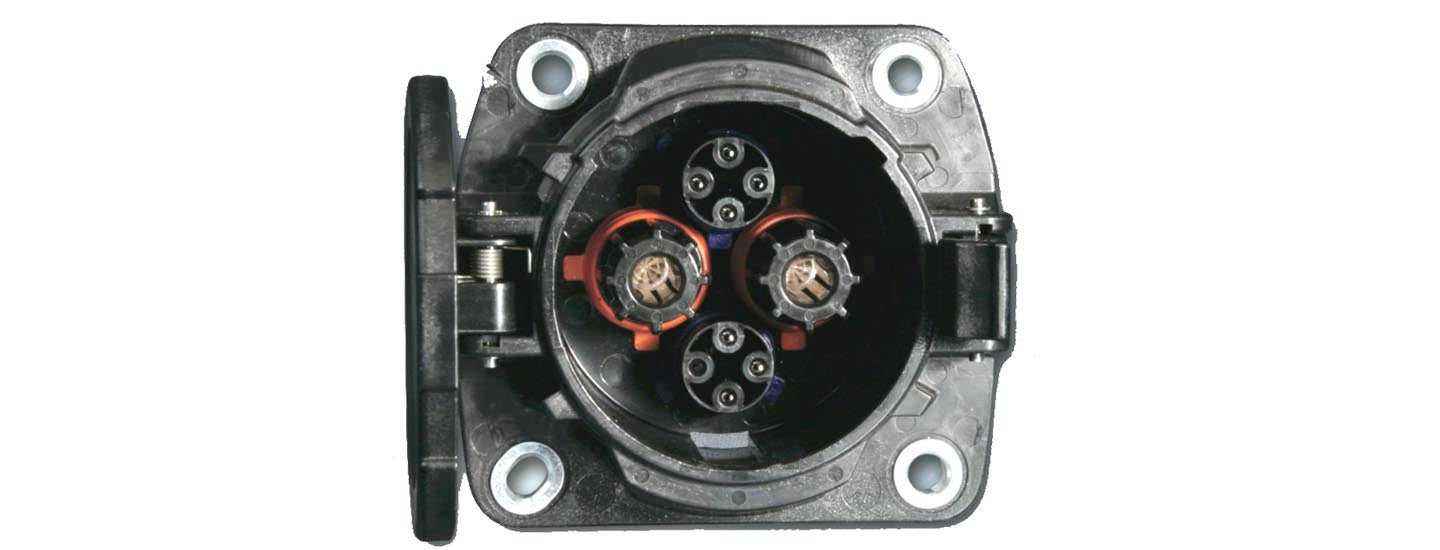
Charging connector in the car
CHAdeMO stands for 'CHArge de MOve', which means 'charge on the move'. Cars that come with a type 1 charging connector often have the option to fast charge via a connector called CHAdeMO. This standard currently delivers up to 100 kW DC (direct current). Thus, charging electric cars with this standard will in most cases take around 30 minutes (0-80%). The CHAdeMO plug is permanently attached to the charging cable at the fast charging station, so you don't need to buy a charging cable to fast charge. The following manufacturers offer electric cars that are compatible with the CHAdeMO plug: BD Otopmotiv, Citroën, Honda, KIA, Mazda, Mitsubishi, Nissan, Peugeot, Subaru, Tesla (with adapter), and Toyota.
COMBINED CHARGING SYSTEM (CCS) - COMBO 1/2
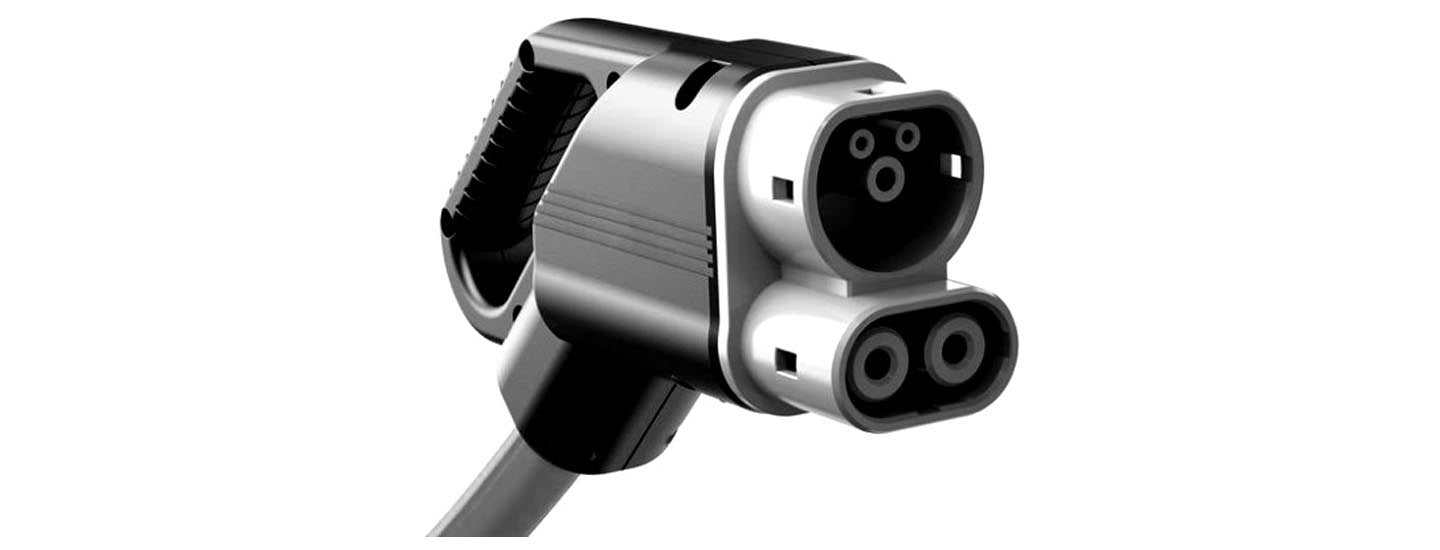
Charging plug for the car

Charging connector in the car
The Combined Charging System (CCS) was developed by the European and American automotive industry as an alternative to the Japanese CHAdeMO. The charging connector in cars in Europe consists of a combination plug with a type 2 plug (upper part) with two additional pins/conductors (lower part) for fast charging. In America, it is called CCS Combo 1 (Type 1) and in Europe, it is called CCS Combo 2 (Type 2). During fast charging, the type contacts (type 2 contact) become an integrated part that communicates with the charging station. Charging electric cars with this standard will also take about 30 minutes (0-80%), as it can deliver up to 350 kW to date. Thus, there is only one charging connector in the car, unlike some other cars (cars with CHAdeMO). The charging cable with the CCS plug will be permanently attached to the cable at a fast charging station, so you don't need to buy a charging cable for fast charging.
TESLA TYPE 2 / SUPERCHARGER (SUC)

Currently, only Tesla's cars use the type 2 connector for both regular charging (AC) and fast charging (DC). Fast charging must be done through Tesla's "supercharger" network. Tesla uses a modified solution based on the type 2 connector, which can also take direct current with a power of 150 kW. It delivers up to 500V and 250A.
Tesla's superchargers are now getting CCS type 2 as a result of CCS Type 2 being adopted as the European fast charging standard. For example, the Tesla Model 3 in Europe has a CCS charging connector in the car and can charge with up to 250 kW. There are separate cables for these at the charging points.
Which factors affect charging speed during fast charging?
The factors that determine how fast charging can take place are the battery's state of charge (SoC) and temperature. The electronics in the car control this, and based on the reporting and calculations in the battery control system, the car will determine how quickly the batteries can receive power.
1. How full the battery is - often referred to as State of Charge (SoC)
The graph below shows an example of a charging curve, with charging speed expressed in kW (vertical axis) and how full the battery is in percentage (horizontal axis).
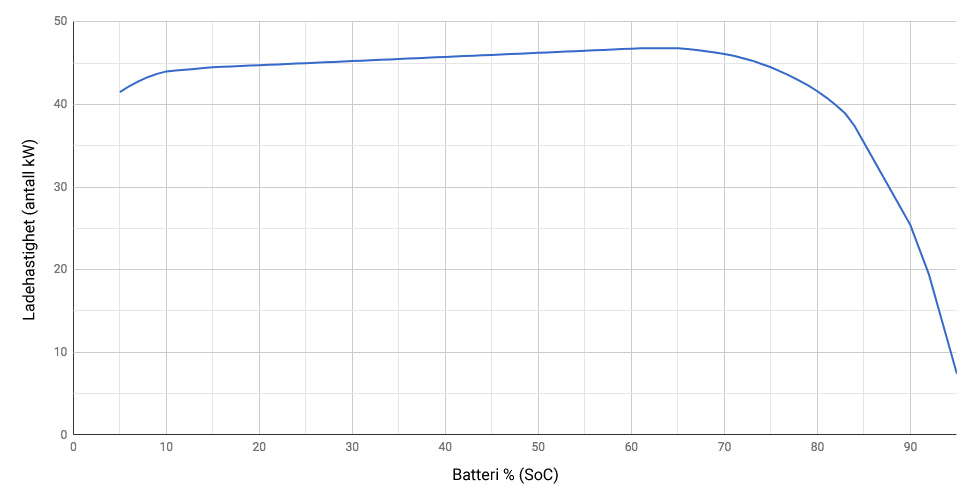
This example shows that the charging speed decreases when the battery is around 70% full, and the charging power is further reduced at 80% and 90% SoC. The charging curve for each car is different and depends on the manufacturer's choices and configuration in their battery control system.
2. How cold or warm the batteries are (temperature)
The battery's optimal operating temperature is around 20-30°C. In winter, the lithium ions/electrons move slower in the electrolyte, and electrochemical processes are sensitive to temperature changes. At the same charging power (number of kW), the cell voltage can be higher at low temperatures than at more ideal battery temperatures. Thus, high charging power at low battery temperatures can potentially damage the battery cells. Therefore, the charging power is reduced to protect the battery, and the battery control system in electric vehicles will reduce the current from the charging point. Similarly, a battery can become too hot when charging, which can also damage the battery cells, thus limiting the charging power to protect the battery.
Many electric cars are therefore equipped with thermal management of the battery, allowing the battery to be cooled or heated depending on the surroundings. This reduces the effect of temperature, making it easier to maintain an optimal operating temperature during charging.
Fast charging in the cold - how long does it take?
Electric vehicles with today's battery packs in the 0-80% range have approximate charging times at different temperatures:
• 10ºC: 30 minutes
• 0ºC: 45 minutes
• -10ºC: 90 minutes
• -20ºC: 90 minutes with battery heating or 3 hours without
Charging time depends on the outside temperature and the battery temperature during fast charging. If the car and battery have been outside for a long time in sub-zero temperatures, it's recommended to drive beforehand to warm up the battery or use standard charging (AC) to heat the battery. The latter also requires the car to utilize a certain charging effect to generate heat in the battery. That's why many cars have battery heaters in Nordic regions.
Why doesn't my vehicle fast charge from 80-100%?
It's unproblematic to charge batteries at high power when there's ample space for electrons. It can be likened to filling a glass of water where, initially, you can pour a lot of water, and as the glass gets full, you need to pour slower to avoid spilling. Therefore, the charging power is reduced once the battery reaches a certain voltage level in the battery cells. This is usually around 80%, and after this, the charging power is decreased to give the lithium ions more time to utilize the cathode's surface area.
This is why charging time for fast charging is given for 0-80%. After 80% full charge, the speed will decrease significantly – in the worst case, down to what we are used to with standard charging. It's not necessarily a power of 50 kW or more from 0-80%. Most experience an average power of around 35 kW, equivalent to about 20-30 minutes depending on battery size (measured in kWh). At the same time, the average power will be higher with larger battery sizes, the charging power of the fast charger, and the car's battery management system (BMS).
 FedEx delivery in the EU
FedEx delivery in the EU
